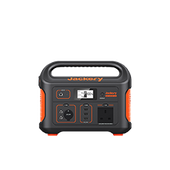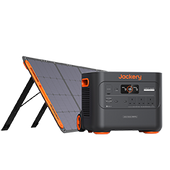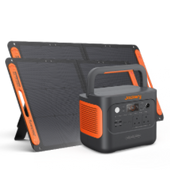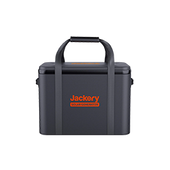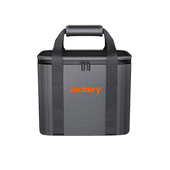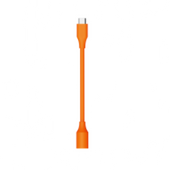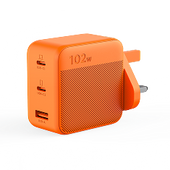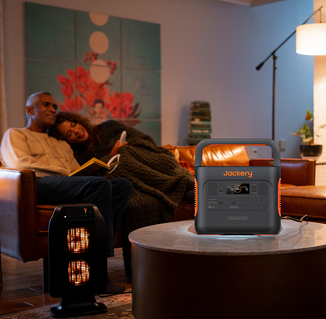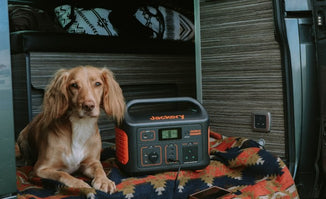Solar Powered Security Camera: Can Solar Generator Power A Security Camera
Making the device much simpler to deploy is choosing a solar-powered security camera. Security cameras powered by the sun are independent systems that can be installed without hard wiring.
A typical security camera's power ranges from 4 to 15 Watts, while the DVR device connected to the CCTV camera uses between 10 and 40 Watts. If your security system is always on, a month's worth of service will run you about $4.
On this page, you will learn what a solar-powered security camera is, how it works, and the solar-powered security camera vs. solar generator for a security camera. Here suggest Jackery solar generators to power your security camera indoors or outdoors.
What is Solar Powered Security Camera
Security cams are easier to install and maintain than ever before. They've rapidly established themselves as the go-to choice for protecting and monitoring your property. With a solar-powered security camera, you can quickly get it operating off the grid because the panel is either integrated into the camera hardware or is included with the camera.
With the addition of a solar panel, the practical restrictions of an outdoor IP security camera are mainly removed. A solar panel allows the surveillance camera to receive continuous power from the sun.
How A Solar-Powered Security Camera Works
Solar-powered security cameras contain small solar panels that transform sunlight into electricity to recharge the cameras' internal rechargeable batteries. The security cameras' built-in inverters can convert the DC power from solar panels into AC electricity to keep charging when the sun is out.
Solar-powered security cameras can also operate through the night by storing energy during the day in their rechargeable batteries.

Solar Powered Security Camera VS. Solar Generator for Security Camera
Solar security cameras do not require wires to attach to power sources, unlike wired security cameras. Instead of using data cables, they connect to home surveillance devices with Wi-Fi. As a result, they are more convenient to install and genuinely wireless security solutions.
Regular wireless security cameras without solar panels are less convenient than solar-powered ones. The latter has to be taken down and then set back up, which can be a hassle. They need a battery replacement or recharge every few months.
Furthermore, while wireless security cameras with solar power can continuously record, most use power-saving mode to save battery life and only activate when motion is detected. This switch introduces delays that can make these cameras miss important moments.
The camera's operation will be disrupted if its battery dies and the solar panel cannot produce enough power from the light it receives. This will have an impact on the stability of its operation. Using a portable solar generator with a high capacity to power a security camera easily is preferable.
|
Types |
Features |
Pros |
Cons |
|
Solar Powered Security Camera |
- Need solar panels, inverter, and battery - Camera resolution - Wi-Fi connection - Better than traditional security cameras |
- Solar energy - Easier to use than wired security camera - Easy to install - Wireless - Wi-Fi connection
|
- Costly - Work not better on cloudy or rainy days - Low battery charging - Influences by Wi-Fi - Need maintenance |
|
Solar Generator for Security Camera |
- Solar panels with a power station - Suitable for traditional and solar-powered security cameras - Varies in capacities and dimensions - Rechargeable |
- Portability - Easy to use - No installation - No maintenance - Eco-friendly - Work on cloudy or rainy days with stored power in the power station - Multiple ports - Multiple recharging methods |
- Some solar generators with large capacities may cost a little (but lower than solar-powered security cameras) |
Solar Powered Security Camera
Solar-powered security cameras have recently become popular when people want to install a wireless video surveillance system. It is a genuinely do-it-yourself system that may not require outsourcing the installation service because the solar panel supplies the power, and the camera supports Wi-Fi connectivity. The system is entirely wire-free.
The camera runs on pure, renewable energy converted into electricity by a solar panel; the internal battery supplies power when it needs to operate at night.
A secondary or backup power source, frequently rechargeable batteries, is also included with most solar-powered cameras. The surveillance camera's solar panel also serves as a battery charger.
But using solar panels to recharge a solar-powered surveillance camera that has run out of battery is difficult. The cost of the solar-powered security camera may be higher than that of a conventional CCTV.
Since solar-powered security cameras use Wi-Fi or 4G LTE technology, they could experience issues with a weak wireless signal, a shaky Wi-Fi connection, or even signal interference.
Solar Generator for Security Camera
Utilizing a portable solar generator to power your security systems is strongly advised because solar panels have limitations and weak signal strength. Additionally, it uses renewable energy, is simple to install, and has limitless power.

The energy from the sun is captured by solar panels on a portable solar generator, which is then stored in a power station for subsequent use. Jackery is the top brand for this kind of solar product. All required is a cable connection between solar panels and a Jackery power station, followed by an outlet for charging the security camera. The installation of the solar-powered security camera, which combines solar panels, an inverter, and a battery, must be done by a professional.
The Jackery solar generators don't require additional maintenance or costs. Still, the solar-powered security camera may require other maintenance if the solar panels break or expert assistance is required.
Moreover, you can recharge the Jackery solar generators using power outlets, carports, and solar panels. This enables the power station to run continuously, even on overcast days or at night.

To power your security system and other home appliances, such as your TV, refrigerator, and more, we highly suggest Jackery Solar Generator 1000 Pro. Also, you can use a Solar Generator 500, 300, or 240 for quick charging of surveillance cameras.
How Many Watts Does A Security Camera Use
Depending on the model, a security camera typically uses 4 to 15 Watts of electricity, while the DVR device connected to a CCTV camera uses 10 to 40 Watts. You will pay about $4 per month for a CCTV security system that is operational around the clock.
The model and specifications impact a security camera's battery usage. Your security CCTV camera will use more energy if it is recording HD-quality video for longer. Some versions have numerous extra features like night vision mode, motion detectors, or lighting that use even more power.
How Much Solar Power Does A Security Camera Need
By multiplying the camera's wattage by the daily hours, you can quickly and easily determine how much solar electricity your CCTV system requires. Here is a formula to calculate the utilization estimates:
Security camera Wh = security camera wattage x hours per day
|
Security Cameras |
Watts |
Length of Use |
Solar Power Needed |
|
Average |
10W |
8H |
80W |
|
TP-Link |
5.4W |
8H |
43.2W |
|
Google Nest Cam IQ |
13W |
8H |
104W |
|
Vivint Outdoor |
7W |
8H |
56W |
|
Ring Floodlight Cam |
15W |
8H |
120W |
Can A Solar Generator Power A Security Camera
A solar-powered security camera can monitor things in off-the-grid or remote locations where running cables would be difficult or prohibitively costly. However, a portable solar generator can also perform the same tasks and more.

Regarding the solar security camera, you need professional installation and maintenance to set up the right solar panels with a suitable inverter and battery. Still, the solar generator is simple and requires no further upkeep or expenses.
Solar generators are more efficient than solar panels for security cameras, particularly at night or on cloudy days. A portable solar generator can meet all your requirements due to its portability, regardless of the security cameras used in your home, front yard, garden, workshop, and more.
Jackery is dedicated to creating quality solar brand that supports your electricity needs. To make the best use of solar energy, we constantly keep protecting the environment in mind. Along with being quiet, fuse-free, and simple to use, all solar generators guarantee an improved user experience.
More than nine kinds of solar generators satisfy all your needs. It is strongly advised to use a Solar Generator 500 to power a security camera, which only requires 4 to 10 Watts of power. They are affordable, portable, and simple to carry.
With a 1002Wh capacity, the Jackery Solar Generator 1000 Pro can power additional indoor and outdoor appliances besides your security cameras. With 4 SolarSaga 200W solar panels, the power station can be completely recharged in just 1.8 hours.
|
Series |
Capacity |
Ports |
Security Camera Watts |
Hours |
|
Jackery Solar Generator 1000 Pro |
1002Wh |
AC Output: 120V, 60Hz, 1000W (2000W Peak) USB-A Output: Quick Charge 3.0, 18W Max USB-C Output: 12V, 10A Car Port: 120V, 60Hz, 15A Max |
Average: 10W TP Link Camera: 5.4W Google Nest Cam IQ: 13W Ring Floodlight Cam: 15W |
Average: 85.2H TP Link Camera: 157.7H Google Nest Cam IQ: 65.5H Ring Floodlight Cam: 56.8H |
|
Jackery Solar Generator 500 |
518Wh |
AC Output: 110V, 60Hz, 500W (1000W Peak) 3*USB-A Output: 5V, 2.4A DC Output: 12V, 10A Car Port: 12V, 10A |
Average: 10W TP Link Camera: 5.4W Google Nest Cam IQ: 13W Ring Floodlight Cam: 15W |
Average: 44H TP Link Camera: 81.5H Google Nest Cam IQ: 33.9H Ring Floodlight Cam: 17.3H |
Solar Powered Security Camera FAQs
The following shows the frequently asked questions about the solar-powered security camera:
1. What size of solar generator do I need to power a security camera?
When sizing your solar generator, remember that the generator should be roughly twice as large as the constant output of the inverter. This is necessary because the generator must run the loads and fill the batteries simultaneously. Rounding up is a good idea to allow for the generator's headroom, particularly at higher elevations where the generator will lose some of its power.
Here is the formula to calculate how long it will take your Jackery solar generators to power your security camera:
Working time = solar generator capacity*0.85 / operating wattage of your security camera
For example, if you use Jackery Solar Generator 1000 Pro (1002Wh capacity) to charge your security camera (15W usage), then the working time is 56.8H (1002Wh*0.85/15W).
2. Do solar-powered security cameras work on cloudy days or at night?
The excess energy stored in the solar security cameras' rechargeable batteries on sunny days allows them to operate for a few days with cloud cover, allowing the solar panels attached to them to continue producing electricity. It is highly recommended to use a portable solar generator if there are frequently cloudy and rainy days to power surveillance cameras.
3. How long do solar-powered security cameras last?
If the solar panel receives enough sunlight daily to recharge the battery, you can anticipate your solar-powered camera to operate forever. Most solar security camera batteries have a charge life of between 1 and 6 months, so they should readily last through several weeks of cloud cover.
Final Thoughts
Solar-powered security cameras refer to surveillance cameras powered by solar panels. Any outdoor security setup would benefit significantly from including solar panels, enabling you to keep your security camera in place for extended periods, provided there is enough sunlight. Hence, Jackery solar generators could be the best alternative for solar-panel-powered security cameras, as they have power stations for storing electricity to charge appliances on cloudy days or even at night.









